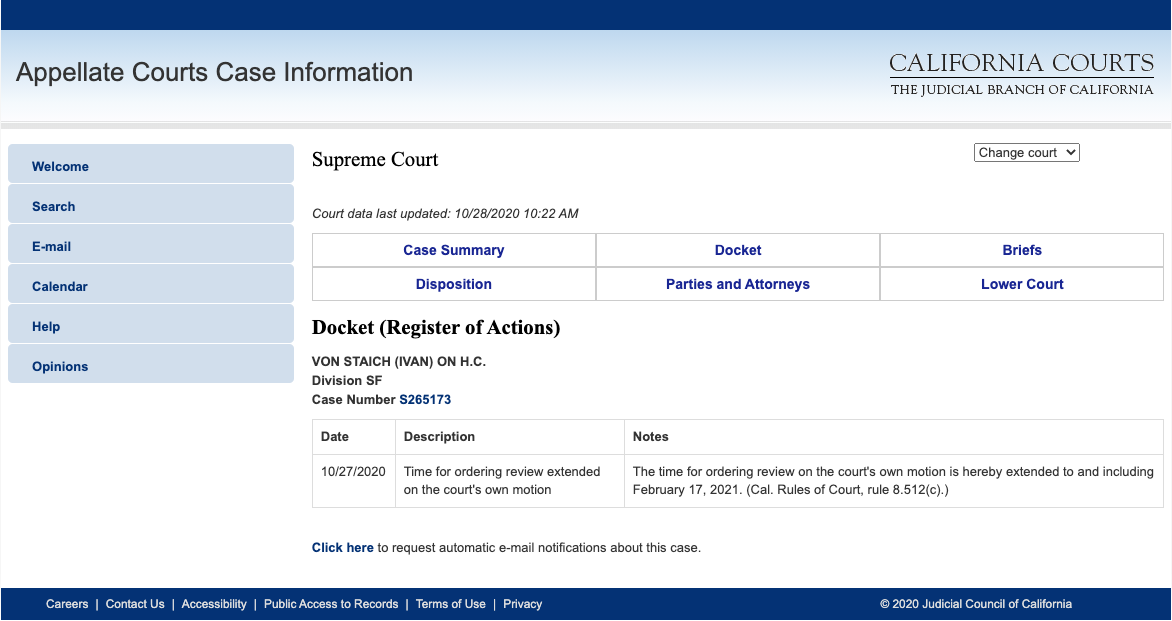
As you see in the image above, the California Supreme Court has extended the 15-day review window for In re Von Staich to 90 days–until Feb. 17, 2021. This gives CDCR more breathing room to decide what they want to do with this decision, and has important implication as to lives inside and additional COVID-19-related legal challenges.
One of the vague aspects of Von Staich was that the Court of Appeal did not give CDCR a deadline for the 50% population reduction. These kinds of orders, especially (but not exclusively) when they are consent decrees, typically come with a period of judicial supervision and a list of benchmarks to reach. In Von Staich, the Court of Appeal left the authority to resolve disputes about the order to the Marin Superior Court, and it seems that Judge Howard is taking up that mantle in the habeas cases pending in his courtroom. Judge Howard originally set the time for a response brief to November 16, under the assumption that by then the Attorney General representative, Denise Yates, would be able to inform the court as to CDCR’s plans. This may or may not happen, though I very much doubt Judge Howard will extend the deadline for the briefs by three entire months.
There is plenty of legal uncertainty, so I don’t have clear answers to some of the obvious questions:
What happens with the Marin Superior Court Cases? As far as we know at this point, the next steps in those cases involve briefs from the lawyers representing incarcerated folks and from the Attorney General’s office. The dates for those briefs were set with the original Von Staich time in mind, and this delay might or might not alter them (though probably not by three whole months.)
What happens with Von Staich? Are they actually going to petition for review? We don’t know. It is possible that this extended timeline gives CDCR time to align forces to release people (the good scenario) or to transfer them (the bad scenario.) But even if they formally comply with the order (see more on this below) they might have another motivation to petition for review. Before long, CDCR will likely be facing multiple civil lawsuits, including for wrongful death, and the lynchpin for those would be the Eighth Amendment violation: deliberate indifference to the health and safety of people inside. The monetary risk alone (having to pay damages to incarcerated people and to family members) is likely to prompt them to try and challenge the Eighth Amendment finding, even if they comply with the remedy.
While we wait to see if CDCR petitions for review, are they still under obligation to comply with the order? This is a good question, and I’ve spoken to lawyers involved in the different lawsuits to figure out an answer. I was under the impression that CDCR has to ask the Supreme Court for a stay pending review, without which they’d have to work on the petition and on the remedy simultaneously. But people who know more about this stuff are telling me that the Von Staich opinion is not binding until the petition for review is denied or until the timeline for review expires.
Finally, here are a few things to watch out for. Given yesterday’s OIG review, it looks like CDCR deceived the Court of Appeal into thinking that, except for population reduction, they did take “commendable” steps to prevent contagion. It turns out that is not the case: CDCR was astonishingly lax in enforcing proper use of PPE inside its facilities. For more on this, see here. In addition, it’s worth pointing out that there are new outbreaks, including several serious ones, in other facilities (SATF comes to mind – close to 200 cases overnight with only 25% of the population tested) and it is therefore crucial to pay attention not only to where people are being transferred from, but also to where they are being transferred to.
A third thing to watch out for is CDCR activity in San Quentin that could put them formally in the court’s good graces but in fact exacerbates the health risks–for example, erecting more tents outside and keeping people in them in close proximity, while the inside of the facility itself appears to be in compliance with social distancing protocols. These are things to document carefully, as they will have bearing on any further litigation on this issue, whether before the Marin Superior Court or before the California Supreme Court.




1 Comment
I have yet to see any mention of the fact that CDCR has created a situation where inmates at San Quentin are in danger of assault from other inmates at any potential receiving facilities if transferred. In part because of COVID-19, but to a greater extent because CDCR turned San Quentin into a “non-designated” prison. Inmates who were formerly in protective custody were placed on the mainline of San Quentin, making ALL inmates at San Quentin targets. There’s also the issue of San Quentin being a “Medical Facility”. A great number of inmates can’t be transferred to other facilities for various medical reasons. One of many concerns is Valley Fever. The same respiratory issues that make inmates susceptible to COVID-19 also make them susceptible to Valley Fever. Just the two reasons I’ve mentioned above should be reason enough to block most, if not all, transfers.